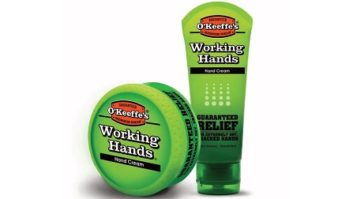(click thumbnail)Fig. 1: Teeth marks. Aluminum hookup wire can be damaged by more than sidecutters.
(click thumbnail)Fig. 2: Squirrels have chewed on aluminum hookup wire.
(click thumbnail)Fig. 3: Woven between the electric conduit is the sign of a visitor.
(click thumbnail)Fig. 4: Harry Bingaman measured the skin at about 6-1/2 feet.Bob Meister was reading the May 24 column about methods for securing signs to towers and fences. He writes, “I always learn something.”
Recall that Mark Ness recommended the aluminum wire that’s used to hold chain-link fences to their support poles as a method of attaching signs.
While this wire is fairly robust and won’t rust away, it can still be unwrapped with strong hands and relatively simple utensils. But for some reason, it’s also attractive to squirrels, which love to run along the top rail of chain-link fences and chew on the aluminum wire.
Figs. 1 and 2 show the damage done to the fence of Bob’s neighbor. Several of the wire ties have been replaced already, but 90 percent of them were damaged over the past dozen years.
Insulated “electrical” wire is probably much better, and it needs to be twisted, soldered, welded, whatever, to keep prying hands, screwdrivers and pliers from coming along and undoing all your hard work.
Any type of wire, though, is easy to cut with one of several types of pliers, side cutters and even garden pruning tools. The more secure, the better. Maybe short lengths of plastic-coated stainless steel aircraft cable are worth considering. One long piece of this cable, woven between the fence and the sign, and secured with a bolt clamp should discourage vandals.
Another thought: If there’s an outer security/property fence and an inner tower/protective fence, consider putting the signs on the inside of the inner-most fence. This may make the sign less likely a target for theft, and since it’s behind two fences, it takes that much more effort and time to get to.
Bob brings up a point when working with metal around broadcast sites. Remember that contact made by rusty metals (bolts, wires, etc.) can also be a source of intermod, mixing and re-radiation, especially with nearby VHF and UHF two-way radio services.
***
Harry Bingaman is engineering manager for Sunbury Broadcast Group in Sunbury, Pa. Commenting on the earlier photo of a dead mouse in a tube carton, he says, “None here!”
Harry recently went for his weekly inspection of the WQKX(FM)/WEGH(FM) site. As he hoofed it back to the power distribution panel he discovered the shed skin of a visitor, seen in Figs. 3 and 4. Harry measured the skin at 6.5 feet, stem to stern.
He’d been wondering why he didn’t need to refill the mouse bait canisters. Now he knows. Harry says it’s most likely a Black Racer, which are great “mousers,” but he adds he’d rather have a cat.
Want to gain some respect? Bring a snakeskin to the station receptionist or salespeople. The skins also will probably guarantee that no one will want to visit your transmitter site.
This is a time of year to use caution not only in but around transmitter sites. Once, as a chief engineer, I decided to use a day of nice weather for cleanup, getting rid of numerous metal poles and leftover fencing materials that had been stored for years at a tower base. There were several 12-foot long, 3-inch diameter poles that had been baking in the sun; they were the first to go.
My assistant lifted one, balancing it on his shoulder. As he tilted the pole, out slithered a long black snake, landing at his feet. I had to stifle a laugh as he did a jig while trying to balance the heavy fence pole, all the while trying to avoid the snake.
***
Wes Boyd with the Cumulus Youngstown cluster saw Grady Moates’ “isocoupler” using two STL dishes spaced apart to get across the base of a hot AM tower.
The picture reminded him of a project a dozen years ago, when he wanted to put an STL antenna on a hot 10 kW AM tower. Isocouplers weren’t available, so Wes’ answer came from radio guru George Marti, who had done something similar at 50 kW WBAP in Fort Worth.
Wes referred to his notes, and per George, at 950 MHz, 4-foot dishes spaced 78 inches dipole to dipole will give 6 dB loss, and plenty of isolation for the 50 kW signal. At 450 MHz, yagi antennas spaced 16-1/2 inches antenna end-to-end will give 4 dB loss, and also worked fine in the 50 kW field.
Thanks, Wes, for the useful information.
















